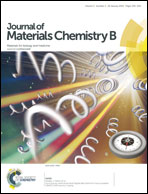Photoinduced anchoring and micropatterning of macroinitiators on polyurethane surfaces for graft polymerization of antifouling brush coatings†
Abstract
Poly[3-azido-2-(2-bromo-2-methylpropanoyloxy)propyl methacrylate] (PAzBrMA) was synthesized as the macroinitiator and anchor for a functional polymer brush coating on polyurethane (PU) films. Ring-opening reaction of the epoxide group of poly(glycidyl methacrylate) with sodium azide produced the hydroxyl and azide functional groups. The hydroxyl groups were substituted with 2-bromoisobutyryl bromide to introduce the alkyl halide initiator. For anchoring, ultraviolet irradiation was applied to convert the azide groups of PAzBrMA physically coated on the PU surface into nitrene intermediates. The nitrene groups reacted with hydrocarbon moieties on the PU surface through hydrogen abstraction to form amine linkages. A photomask could then be employed to create a patterned surface during irradiation. Thus, the anchoring of a PAzBrMA macroinitiator can be achieved under mild conditions, without the use of strong solvents and high temperatures, which will swell or degrade the PU substrates. Finally, 2-hydroxyethyl methacrylate (HEMA) and poly(ethylene glycol) methacrylate (PEGMA) are graft-polymerized on the PAzBrMA-anchored PU film by surface-initiated atom transfer radical polymerization. In comparison with the pristine PU surface, the PU surfaces with grafted HEMA and PEGMA brush coatings were effective in reducing bovine serum albumin adsorption (protein fouling), adhesion of Staphylococcus epidermidis and Pseudomonas sp. (microfouling), and barnacle cyprid settlement (macrofouling). The present surface modification approach provides a simple and versatile means for micropatterning and functionalization of the polymer surfaces.


 Please wait while we load your content...
Please wait while we load your content...